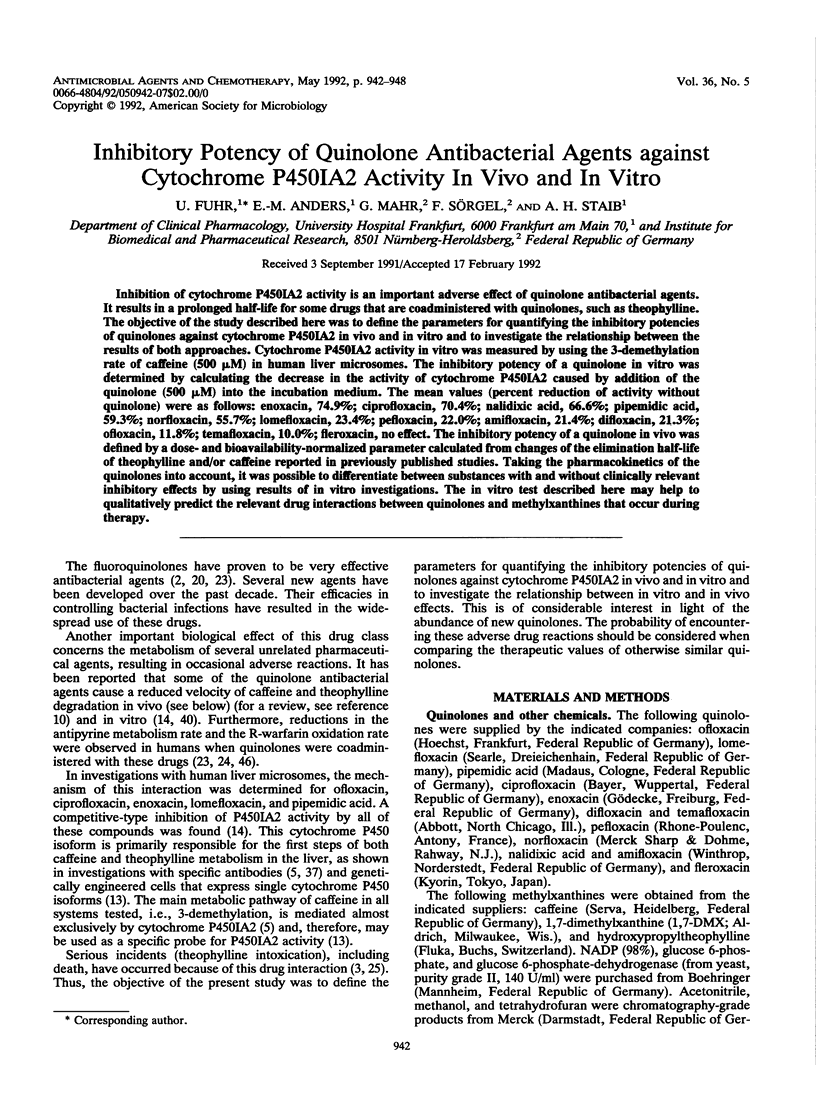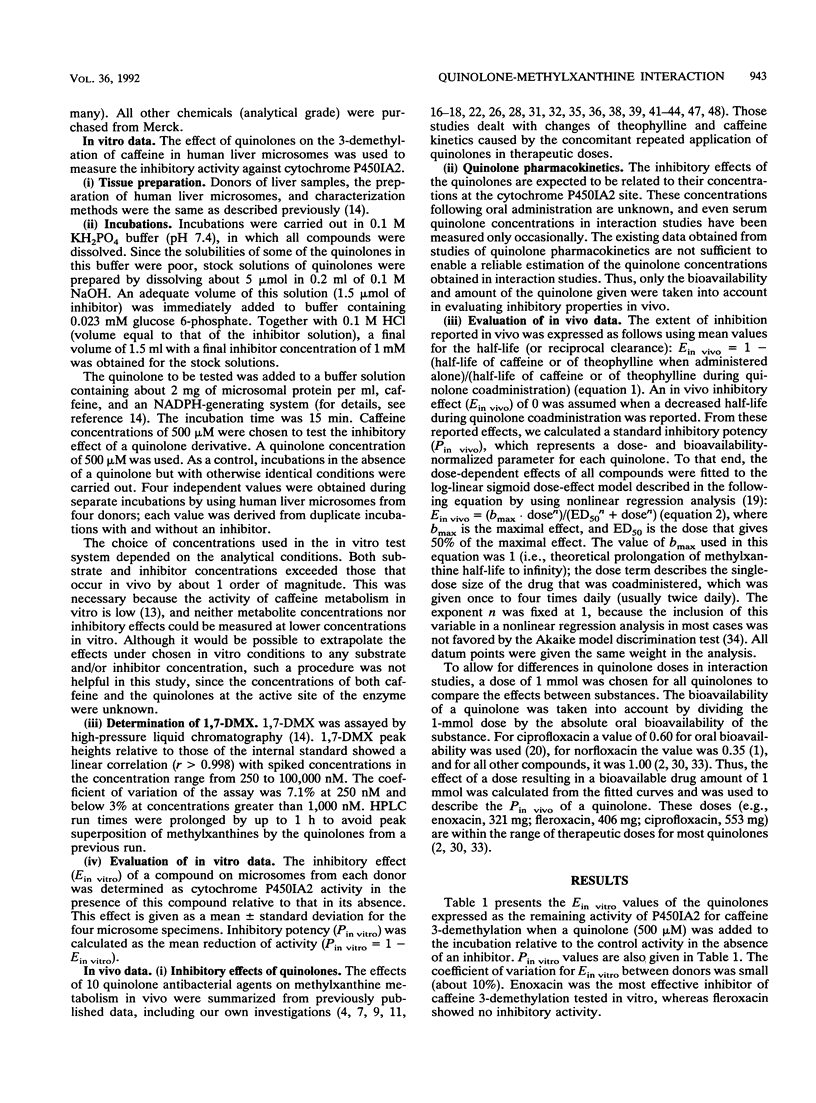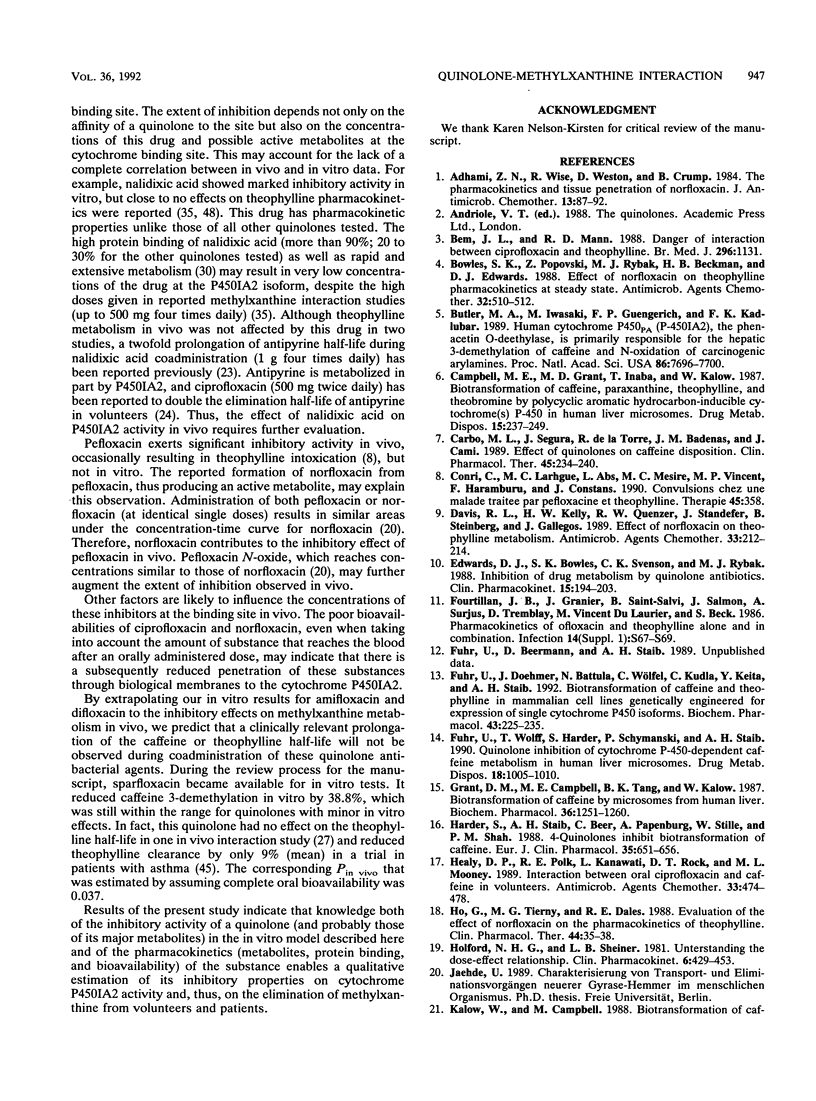Abstract
Inhibition of cytochrome P450IA2 activity is an important adverse effect of quinolone antibacterial agents. It results in a prolonged half-life for some drugs that are coadministered with quinolones, such as theophylline. The objective of the study described here was to define the parameters for quantifying the inhibitory potencies of quinolones against cytochrome P450IA2 in vivo and in vitro and to investigate the relationship between the results of both approaches. Cytochrome P450IA2 activity in vitro was measured by using the 3-demethylation rate of caffeine (500 microM) in human liver microsomes. The inhibitory potency of a quinolone in vitro was determined by calculating the decrease in the activity of cytochrome P450IA2 caused by addition of the quinolone (500 microM) into the incubation medium. The mean values (percent reduction of activity without quinolone) were as follows: enoxacin, 74.9%; ciprofloxacin, 70.4%; nalidixic acid, 66.6%; pipemidic acid, 59.3%; norfloxacin, 55.7%; lomefloxacin, 23.4%; pefloxacin, 22.0%; amifloxacin, 21.4%; difloxacin, 21.3%; ofloxacin, 11.8%; temafloxacin, 10.0%; fleroxacin, no effect. The inhibitory potency of a quinolone in vivo was defined by a dose- and bioavailability-normalized parameter calculated from changes of the elimination half-life of theophylline and/or caffeine reported in previously published studies. Taking the pharmacokinetics of the quinolones into account, it was possible to differentiate between substances with and without clinically relevant inhibitory effects by using results of in vitro investigations. The in vitro test described here may help to qualitatively predict the relevant drug interactions between quinolones and methylxanthines that occur during therapy.
Full text
PDF






Selected References
These references are in PubMed. This may not be the complete list of references from this article.
- Adhami Z. N., Wise R., Weston D., Crump B. The pharmacokinetics and tissue penetration of norfloxacin. J Antimicrob Chemother. 1984 Jan;13(1):87–92. doi: 10.1093/jac/13.1.87. [DOI] [PubMed] [Google Scholar]
- Bem J. L., Mann R. D. Danger of interaction between ciprofloxacin and theophylline. Br Med J (Clin Res Ed) 1988 Apr 16;296(6629):1131–1131. doi: 10.1136/bmj.296.6629.1131. [DOI] [PMC free article] [PubMed] [Google Scholar]
- Bowles S. K., Popovski Z., Rybak M. J., Beckman H. B., Edwards D. J. Effect of norfloxacin on theophylline pharmacokinetics at steady state. Antimicrob Agents Chemother. 1988 Apr;32(4):510–512. doi: 10.1128/aac.32.4.510. [DOI] [PMC free article] [PubMed] [Google Scholar]
- Butler M. A., Iwasaki M., Guengerich F. P., Kadlubar F. F. Human cytochrome P-450PA (P-450IA2), the phenacetin O-deethylase, is primarily responsible for the hepatic 3-demethylation of caffeine and N-oxidation of carcinogenic arylamines. Proc Natl Acad Sci U S A. 1989 Oct;86(20):7696–7700. doi: 10.1073/pnas.86.20.7696. [DOI] [PMC free article] [PubMed] [Google Scholar]
- Campbell M. E., Grant D. M., Inaba T., Kalow W. Biotransformation of caffeine, paraxanthine, theophylline, and theobromine by polycyclic aromatic hydrocarbon-inducible cytochrome(s) P-450 in human liver microsomes. Drug Metab Dispos. 1987 Mar-Apr;15(2):237–249. [PubMed] [Google Scholar]
- Carbó M., Segura J., De la Torre R., Badenas J. M., Camí J. Effect of quinolones on caffeine disposition. Clin Pharmacol Ther. 1989 Mar;45(3):234–240. doi: 10.1038/clpt.1989.23. [DOI] [PubMed] [Google Scholar]
- Conri C., Lartigue M. C., Abs L., Mestre M. C., Vincent M. P., Haramburu F., Constans J. Convulsions chez une malade traitée par péfloxacine et théophylline. Therapie. 1990 Jul-Aug;45(4):358–358. [PubMed] [Google Scholar]
- Davis R. L., Kelly H. W., Quenzer R. W., Standefer J., Steinberg B., Gallegos J. Effect of norfloxacin on theophylline metabolism. Antimicrob Agents Chemother. 1989 Feb;33(2):212–214. doi: 10.1128/aac.33.2.212. [DOI] [PMC free article] [PubMed] [Google Scholar]
- Edwards D. J., Bowles S. K., Svensson C. K., Rybak M. J. Inhibition of drug metabolism by quinolone antibiotics. Clin Pharmacokinet. 1988 Sep;15(3):194–204. doi: 10.2165/00003088-198815030-00004. [DOI] [PubMed] [Google Scholar]
- Fourtillan J. B., Granier J., Saint-Salvi B., Salmon J., Surjus A., Tremblay D., Vincent Du Laurier M., Beck S. Pharmacokinetics of ofloxacin and theophylline alone and in combination. Infection. 1986;14 (Suppl 1):S67–S69. doi: 10.1007/BF01645203. [DOI] [PubMed] [Google Scholar]
- Fuhr U., Doehmer J., Battula N., Wölfel C., Kudla C., Keita Y., Staib A. H. Biotransformation of caffeine and theophylline in mammalian cell lines genetically engineered for expression of single cytochrome P450 isoforms. Biochem Pharmacol. 1992 Jan 22;43(2):225–235. doi: 10.1016/0006-2952(92)90282-n. [DOI] [PubMed] [Google Scholar]
- Fuhr U., Wolff T., Harder S., Schymanski P., Staib A. H. Quinolone inhibition of cytochrome P-450-dependent caffeine metabolism in human liver microsomes. Drug Metab Dispos. 1990 Nov-Dec;18(6):1005–1010. [PubMed] [Google Scholar]
- Grant D. M., Campbell M. E., Tang B. K., Kalow W. Biotransformation of caffeine by microsomes from human liver. Kinetics and inhibition studies. Biochem Pharmacol. 1987 Apr 15;36(8):1251–1260. doi: 10.1016/0006-2952(87)90078-5. [DOI] [PubMed] [Google Scholar]
- Harder S., Staib A. H., Beer C., Papenburg A., Stille W., Shah P. M. 4-quinolones inhibit biotransformation of caffeine. Eur J Clin Pharmacol. 1988;35(6):651–656. doi: 10.1007/BF00637602. [DOI] [PubMed] [Google Scholar]
- Healy D. P., Polk R. E., Kanawati L., Rock D. T., Mooney M. L. Interaction between oral ciprofloxacin and caffeine in normal volunteers. Antimicrob Agents Chemother. 1989 Apr;33(4):474–478. doi: 10.1128/aac.33.4.474. [DOI] [PMC free article] [PubMed] [Google Scholar]
- Ho G., Tierney M. G., Dales R. E. Evaluation of the effect of norfloxacin on the pharmacokinetics of theophylline. Clin Pharmacol Ther. 1988 Jul;44(1):35–38. doi: 10.1038/clpt.1988.109. [DOI] [PubMed] [Google Scholar]
- Holford N. H., Sheiner L. B. Understanding the dose-effect relationship: clinical application of pharmacokinetic-pharmacodynamic models. Clin Pharmacokinet. 1981 Nov-Dec;6(6):429–453. doi: 10.2165/00003088-198106060-00002. [DOI] [PubMed] [Google Scholar]
- Kuzuya T., Takagi K., Apichartpichean R., Muraoka I., Nadai M., Hasegawa T. Kinetic interaction between theophylline and a newly developed quinolone, NY-198. J Pharmacobiodyn. 1989 Jul;12(7):405–409. doi: 10.1248/bpb1978.12.405. [DOI] [PubMed] [Google Scholar]
- Ludwig E., Graber H., Perényi T., Benesch L. Gyógyszerinterakciós vizsgálatok nalidixsavval és oxolinsavval. Orv Hetil. 1975 Dec 14;116(50):2947–2948. [PubMed] [Google Scholar]
- Ludwig E., Székely E., Csiba A., Graber H. The effect of ciprofloxacin on antipyrine metabolism. J Antimicrob Chemother. 1988 Jul;22(1):61–67. doi: 10.1093/jac/22.1.61. [DOI] [PubMed] [Google Scholar]
- Maesen F. P., Teengs J. P., Baur C., Davies B. I. Quinolones and raised plasma concentrations of theophylline. Lancet. 1984 Sep 1;2(8401):530–530. doi: 10.1016/s0140-6736(84)92617-5. [DOI] [PubMed] [Google Scholar]
- Mizuki Y., Kamaura M., Yamaguchi T., Sekine Y., Hashimoto M. Interaction of enoxacin with theophylline in rats. Arzneimittelforschung. 1989 May;39(5):593–597. [PubMed] [Google Scholar]
- Neuman M. Clinical pharmacokinetics of the newer antibacterial 4-quinolones. Clin Pharmacokinet. 1988 Feb;14(2):96–121. doi: 10.2165/00003088-198814020-00003. [DOI] [PubMed] [Google Scholar]
- Niki Y., Soejima R., Kawane H., Sumi M., Umeki S. New synthetic quinolone antibacterial agents and serum concentration of theophylline. Chest. 1987 Oct;92(4):663–669. doi: 10.1378/chest.92.4.663. [DOI] [PubMed] [Google Scholar]
- Nix D. E., DeVito J. M., Whitbread M. A., Schentag J. J. Effect of multiple dose oral ciprofloxacin on the pharmacokinetics of theophylline and indocyanine green. J Antimicrob Chemother. 1987 Feb;19(2):263–269. doi: 10.1093/jac/19.2.263. [DOI] [PubMed] [Google Scholar]
- Nix D. E., Schentag J. J. The quinolones: an overview and comparative appraisal of their pharmacokinetics and pharmacodynamics. J Clin Pharmacol. 1988 Feb;28(2):169–178. doi: 10.1002/j.1552-4604.1988.tb05740.x. [DOI] [PubMed] [Google Scholar]
- Perrella F. W. EZ-FIT: a practical curve-fitting microcomputer program for the analysis of enzyme kinetic data on IBM-PC compatible computers. Anal Biochem. 1988 Nov 1;174(2):437–447. doi: 10.1016/0003-2697(88)90042-5. [DOI] [PubMed] [Google Scholar]
- Prince R. A., Casabar E., Adair C. G., Wexler D. B., Lettieri J., Kasik J. E. Effect of quinolone antimicrobials on theophylline pharmacokinetics. J Clin Pharmacol. 1989 Jul;29(7):650–654. doi: 10.1002/j.1552-4604.1989.tb03394.x. [DOI] [PubMed] [Google Scholar]
- Robson R. A., Begg E. J., Atkinson H. C., Saunders D. A., Frampton C. M. Comparative effects of ciprofloxacin and lomefloxacin on the oxidative metabolism of theophylline. Br J Clin Pharmacol. 1990 Apr;29(4):491–493. doi: 10.1111/j.1365-2125.1990.tb03669.x. [DOI] [PMC free article] [PubMed] [Google Scholar]
- Robson R. A., Miners J. O., Matthews A. P., Stupans I., Meller D., McManus M. E., Birkett D. J. Characterisation of theophylline metabolism by human liver microsomes. Inhibition and immunochemical studies. Biochem Pharmacol. 1988 May 1;37(9):1651–1659. doi: 10.1016/0006-2952(88)90423-6. [DOI] [PubMed] [Google Scholar]
- Rogge M. C., Solomon W. R., Sedman A. J., Welling P. G., Toothaker R. D., Wagner J. G. The theophylline-enoxacin interaction: I. Effect of enoxacin dose size on theophylline disposition. Clin Pharmacol Ther. 1988 Nov;44(5):579–587. doi: 10.1038/clpt.1988.197. [DOI] [PubMed] [Google Scholar]
- Sano M., Yamamoto I., Ueda J., Yoshikawa E., Yamashina H., Goto M. Comparative pharmacokinetics of theophylline following two fluoroquinolones co-administration. Eur J Clin Pharmacol. 1987;32(4):431–432. doi: 10.1007/BF00543982. [DOI] [PubMed] [Google Scholar]
- Sarkar M., Polk R. E., Guzelian P. S., Hunt C., Karnes H. T. In vitro effect of fluoroquinolones on theophylline metabolism in human liver microsomes. Antimicrob Agents Chemother. 1990 Apr;34(4):594–599. doi: 10.1128/aac.34.4.594. [DOI] [PMC free article] [PubMed] [Google Scholar]
- Schwartz J., Jauregui L., Lettieri J., Bachmann K. Impact of ciprofloxacin on theophylline clearance and steady-state concentrations in serum. Antimicrob Agents Chemother. 1988 Jan;32(1):75–77. doi: 10.1128/aac.32.1.75. [DOI] [PMC free article] [PubMed] [Google Scholar]
- Staib A. H., Harder S., Fuhr U., Wack C. Interaction of quinolones with the theophylline metabolism in man: investigations with lomefloxacin and pipemidic acid. Int J Clin Pharmacol Ther Toxicol. 1989 Jun;27(6):289–283. [PubMed] [Google Scholar]
- Takagi K., Yamaki K., Nadai M., Kuzuya T., Hasegawa T. Effect of a new quinolone, sparfloxacin, on the pharmacokinetics of theophylline in asthmatic patients. Antimicrob Agents Chemother. 1991 Jun;35(6):1137–1141. doi: 10.1128/aac.35.6.1137. [DOI] [PMC free article] [PubMed] [Google Scholar]
- Toon S., Hopkins K. J., Garstang F. M., Aarons L., Sedman A., Rowland M. Enoxacin-warfarin interaction: pharmacokinetic and stereochemical aspects. Clin Pharmacol Ther. 1987 Jul;42(1):33–41. doi: 10.1038/clpt.1987.104. [DOI] [PubMed] [Google Scholar]
- Wijnands W. J., Janssen T. J., Guelen P. J., Vree T. B., De Witte T. M. The influence of ofloxacin and enoxacin on the metabolic pathways of theophylline in healthy volunteers. A pilot study. Pharm Weekbl Sci. 1988 Dec 9;10(6):272–276. doi: 10.1007/BF02219667. [DOI] [PubMed] [Google Scholar]
- Wijnands W. J., Vree T. B., van Herwaarden C. L. The influence of quinolone derivatives on theophylline clearance. Br J Clin Pharmacol. 1986 Dec;22(6):677–683. doi: 10.1111/j.1365-2125.1986.tb02957.x. [DOI] [PMC free article] [PubMed] [Google Scholar]


